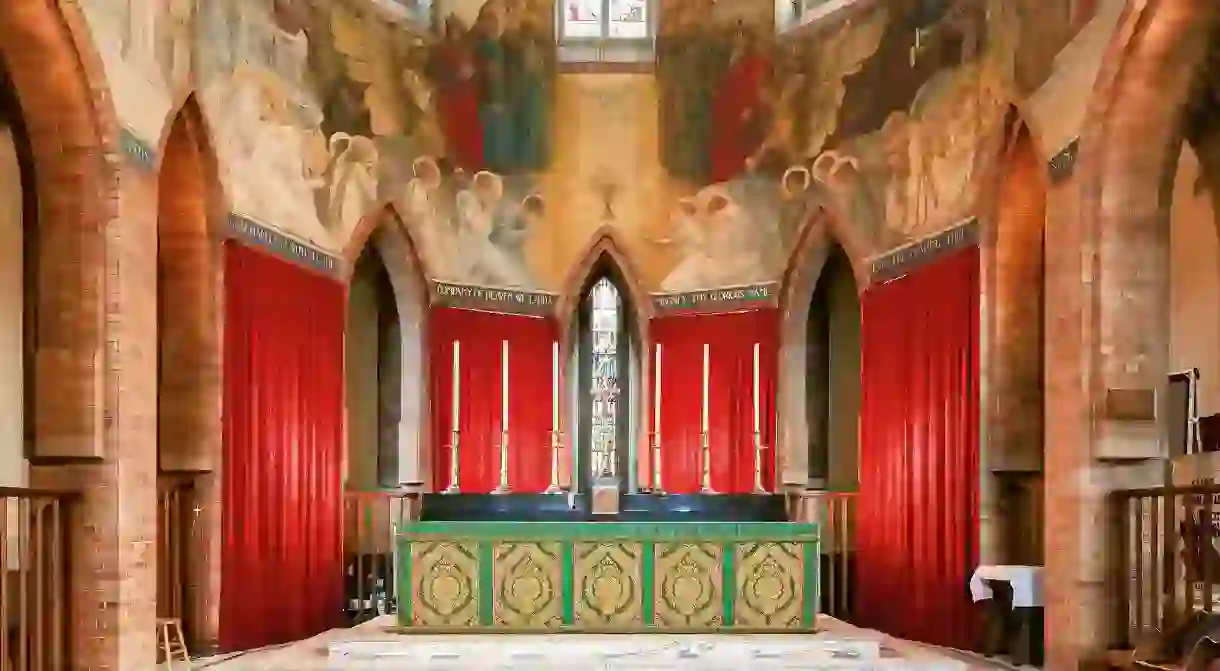London’s Most Striking Modern Churches

From a 1960s spaceship in Catford to a church – complete with sauna – straight out of Finland, London’s Modern churches bring a sense of the unexpected, as well as the divine, to the city’s architecture.
For many, ecclesiastical architecture means stained-glass windows and cross-topped spires that break up the skyline, but the 20th century brought a shift to this branch of the discipline, particularly in London. Modern architects redefined the traditional church layout, introduced innovative materials to their designs and reinterpreted classic symbolism in fresh and exciting ways. These are seven of the UK capital’s most captivating churches from the past century.
John Keble Church, Mill Hill (1936)
Timeless yet completely modern, this imposing landmark in North West London, influenced by Swedish architecture, became a model for post-war church design. Highly innovative, its concrete diagrid (a framework of intersecting beams) was the first of its kind in the country. Other novel and notable features include the location of the choir at the heart of the congregation and the subsequent absence of a conventional one-strip aisle.

St Barnabas, Ealing (1916)
The crowning glory of this Grade II-listed church in Ealing is the painting in the apse. James Clark created the work, which measures 69ft in length and 25ft in height, on canvas, and it was then plastered to the wall using white lead. The building itself was designed by Ernest Charles Shearman, who was inspired by the lofty churches of Medieval Italy and the flourishes of Gothic Romanticism.

St Saviour, Eltham (1933)
More like a fortress than a church, this Modern building by Cachemaille-Day takes its inspiration from German Expressionism and Scandinavian design. Tall, jagged fins of purple-grey brick, punctuated by stunning blue glass, dominate the interior and exterior; a concrete statue of Christ by Donald Hastings stands behind the altar.

Finnish Church, Rotherhithe (1958)
Easily mistaken for an office block from the outside, this Grade II-listed church was built as a ‘home from home’ for Finnish seamen working in the nearby docks. In classic Scandinavian style, natural materials feature throughout and light floods the double-height space. There’s a mini library, a shop selling traditional Finnish products, a hostel, a cafeteria offering Nordic pastries, and even a sauna.

St Paul’s Church, Harringay (1993)
The simple geometric forms of Peter Jenkins’s small but striking church in North London are unmistakably Postmodern. From the street, a zinc-clad equilateral triangle with an eight-metre-high window appears to float above symmetrical rectangular brick walls, which part in the middle to allow for an inconspicuous entrance. The design replaced a Victorian Gothic church that was destroyed by fire in the 1980s.

St Laurence, Catford (1968)
Referred to as the ‘space-age’ church thanks to its distinctive design, St Laurence’s defining feature is its saucer-like concrete roof embellished with a bold tessellated pattern. The geometric theme dominates the interior of this Grade II-listed church, with bespoke curved pews, a circular ‘halo’ behind the altar and abstract stained-glass windows by T Carter Shapland.

Lumen URC, King’s Cross (2008)
A dramatic white cone pierces the heart of this renovated 1960s brick church, and a circular window allows daylight to beam downwards. A private space for worship and contemplation has been carved out of the sculptural form, separating a community café from the body of the church, which faces the original stained-glass window.

100 Churches 100 Years by Twentieth Century Society is published by Batsford. Photographs by John East. Buy your copy here.













